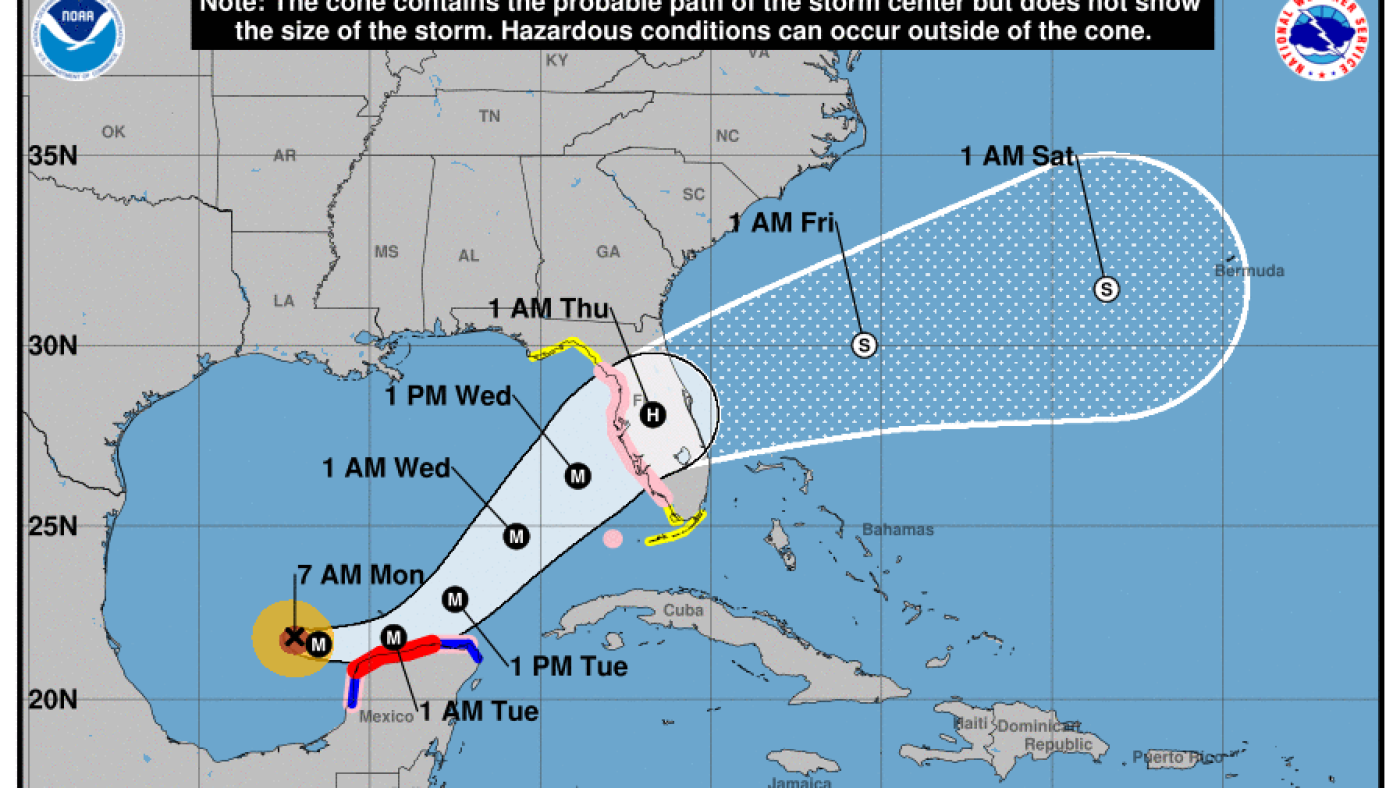Early models show Milton making landfall in Florida midweek before exiting into the Atlantic Ocean, sparing many of the states hardest hit by Helene.
National Hurricane Center
hide caption
toggle caption
National Hurricane Center
Less than two weeks after Hurricane Helene slammed into Florida’s Gulf Coast and wreaked a path of destruction across the southeastern U.S., the state is again on high alert for another rapidly intensifying storm.
Forecasters upgraded Milton from a tropical storm to a hurricane on Sunday, a day earlier than expected, and warn that it is poised to reach Category 4 strength before making landfall in Florida midweek.
It strengthened into a “major” Category 3 hurricane early Monday morning when its maximum sustained winds started nearing 125 mph. It quickly intensified to Category 4 status with maximum sustained winds of 150 mph, the National Hurricane Center said just after 9 a.m. ET.
8:05 AM CDT Monday Update: Milton rapidly intensifies into a category 4 hurricane. The maximum sustained winds have now increased to 150 mph (240 km/h) and the minimum pressure has fallen to 940 mb. pic.twitter.com/wlJXbB5lkr
— National Hurricane Center (@NHC_Atlantic) October 7, 2024
At that point, the storm was about 150 miles west-northwest of Progreso, Mexico, and about 735 miles west-southwest of Tampa. The coast of the Yucatan Peninsula is under a hurricane warning, while hurricane watches, storm surge watches and tropical storm watches and warnings are in effect for parts of the west coast of the Florida Peninsula.
Milton is expected to move just north of the Yucatan Peninsula on Monday and Tuesday before crossing the eastern Gulf of Mexico and approaching Florida’s west coast by Wednesday.
The NHC says most models agree that Milton will cross the Florida Peninsula, though people “should not focus on the exact track” because models still disagree about the exact location and timing of landfall.
Even so, forecasters warn that it is likely to be a “large and powerful hurricane at landfall in Florida, with life-threatening hazards along portions of the coastline.”
They say areas of heavy rainfall will impact portions of Florida on Monday, and again on Tuesday through Wednesday night, bringing “the risk of considerable flash, urban and areal flooding,” as well as the potential for moderate to major river flooding.
Parts of the Florida Peninsula and Keys could see 5 to 10 inches of rain through Wednesday night, with localized totals up to 15 inches in some areas.
There is also a growing risk of life-threatening storm surge and damaging winds for parts of Florida’s west coast beginning late Tuesday or early Wednesday. Forecasters say it could raise water levels to as high as 8 to 12 feet in coastal areas of Florida, including Tampa Bay.
“Residents in that area should follow any advice given by local officials and evacuate if told to do so,” the NHC said, referring to the west coast of the peninsula.
Floridians are bracing for evacuations and impact
Florida Gov. Ron DeSantis has already expanded an emergency declaration to cover 51 of the state’s 67 counties and is warning people across the peninsula to prepare.
“Do not get wedded to the cone,” he tweeted on Sunday. “Floridians should prepare now for potential impacts, even if you live outside of the forecast cone. We recommend following all evacuation orders from your local officials.”
Florida Emergency Management Director Kevin Guthrie said on Sunday that the state is preparing “for the largest evacuation that we have seen most likely since 2017 Hurricane Irma,” when nearly 6.8 million Floridians left their homes, resulting in statewide traffic jams.
But he also cautioned inland residents who don’t live in an evacuation zone or depend on electricity for medical needs that “it may be better for you to just stay in place.”
Several Florida counties have ordered evacuations starting as early as Monday morning.
Manatee County and Pasco County have ordered the evacuation of residents in certain low-lying areas, mobile homes and RVs, while Pinellas County ordered the evacuation of all residential healthcare facilities within certain zones.
Emergency officials are urging Floridians to look up their zone, plan an evacuation route and leave as soon as they’re ordered to do so.
Guthrie also said Floridians should take into account that many are still recovering from Helene: Did they use up their reserves of water, food, pet food? Do they need to buy fresh batteries? Have they restocked their supply kits to last each family member up to seven days?
“Please make sure you’re doing that today,” he said.
Lines started forming at gas stations on Sunday as people stocked up on fuel, water and other supplies, member station WGCU reported.
It notes that public school districts in many counties will be closed from Monday through at least Wednesday and that Florida Gulf Coast University — near Fort Myers — will close its campus Tuesday and Wednesday, after shifting to remote operations.
The St. Pete-Clearwater International Airport has already announced the cancellation of all Allegiant Air flights on Wednesday and Thursday.
Milton is forecast to spare other states submerged by Helene
Milton is poised to strike an area still recovering from Helene’s Category 4 winds and rains.
But it is expected to exit into the Atlantic Ocean, sparing many of the southeastern states that were hit hardest by Helene, including Georgia and the Carolinas.
More than 220 people were killed by Helene, one of the deadliest hurricanes to hit the mainland U.S. since Katrina in 2005. The Associated Press reports that about half of the victims were in North Carolina, where historic flooding destroyed entire communities.
Abnormally warm water in the Gulf of Mexico, fueled by human-caused climate change, has made it easier for hurricanes to strengthen rapidly and bring even more wind and rain ashore.
Milton is the ninth hurricane to form in the 2024 Atlantic hurricane season, which runs from June through November. It’s the fifth to form since Sept. 25 alone, breaking a previous record of two during that period.
And this is officially the first time three simultaneous hurricanes have been recorded in the Atlantic Ocean after September, according to storm researcher Philip Klotzbach. In addition to Milton, Hurricanes Kirk and Leslie are also brewing.







